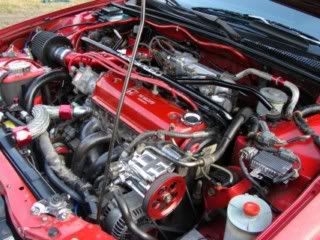OK, this is just me posting about a possible setup that I gathered from PirateMcFred's setup on H-T. Correct me if I'm wrong but his setup used H-series pistons on a F23 rotating assembly and had to do serious modification to the combustion chamber in order to clear the additional 0.040" of compression height of the piston. Now, others on that forum talk about the ability to use K-series and F20C pistons on top of the F23 rotating assemblies because both of them incorporate the same compression height. So it would seem an easy choice from here for those who want to do an F23 build to chose the pistons with the compression ratio they wanted. Only I'm almost positive that the F23 and K20/F20C don't share the same combustion chamber volume. Does anyone know what this value is?
Basically, here is my interest in this swap:
It's a cheaper engine to begin with than H22
It has VTEC
It has the ability to easily accept an H22 head later down the road
I'm not going to argue that it's better in such and such aspects, blah, blah. that's all driving styles and application hooplah. I do think this could be the basis for a cheap swap that allowed the user to run very high compression(due to the selection of aftermarket K20/F20C pistons), and the biggest selling point, the ability to easily accept an H22 head later down the road.
Where are my flaws in this design? I know there's got to be some. For instance a new header purchase would be a necessity. I also have no idea about the IACV/FIV/or MAP sensor mounting on this intake. Would it just be a rewiring issue. As far as OBD-1 converting goes, reuse your F22 distributor and run a remapped P28. I'm probably not going to attempt this anytime soon unless I accidentally happen upon an F23 VTEC so basically this is just to keep it going between me and Glory. Your move.
Basically, here is my interest in this swap:
It's a cheaper engine to begin with than H22
It has VTEC
It has the ability to easily accept an H22 head later down the road
I'm not going to argue that it's better in such and such aspects, blah, blah. that's all driving styles and application hooplah. I do think this could be the basis for a cheap swap that allowed the user to run very high compression(due to the selection of aftermarket K20/F20C pistons), and the biggest selling point, the ability to easily accept an H22 head later down the road.
Where are my flaws in this design? I know there's got to be some. For instance a new header purchase would be a necessity. I also have no idea about the IACV/FIV/or MAP sensor mounting on this intake. Would it just be a rewiring issue. As far as OBD-1 converting goes, reuse your F22 distributor and run a remapped P28. I'm probably not going to attempt this anytime soon unless I accidentally happen upon an F23 VTEC so basically this is just to keep it going between me and Glory. Your move.




Comment